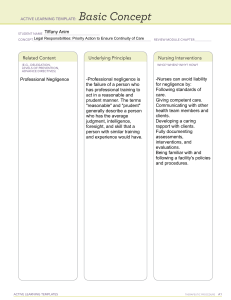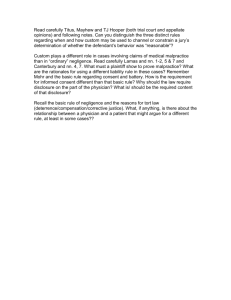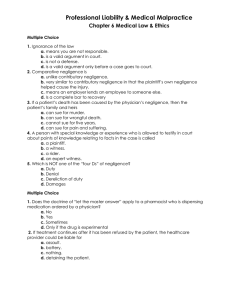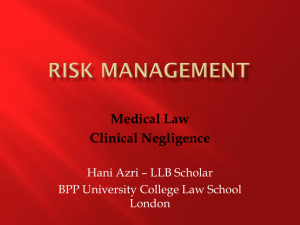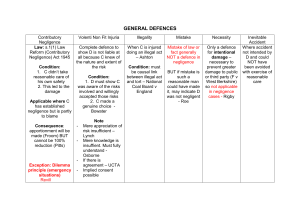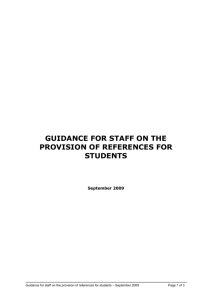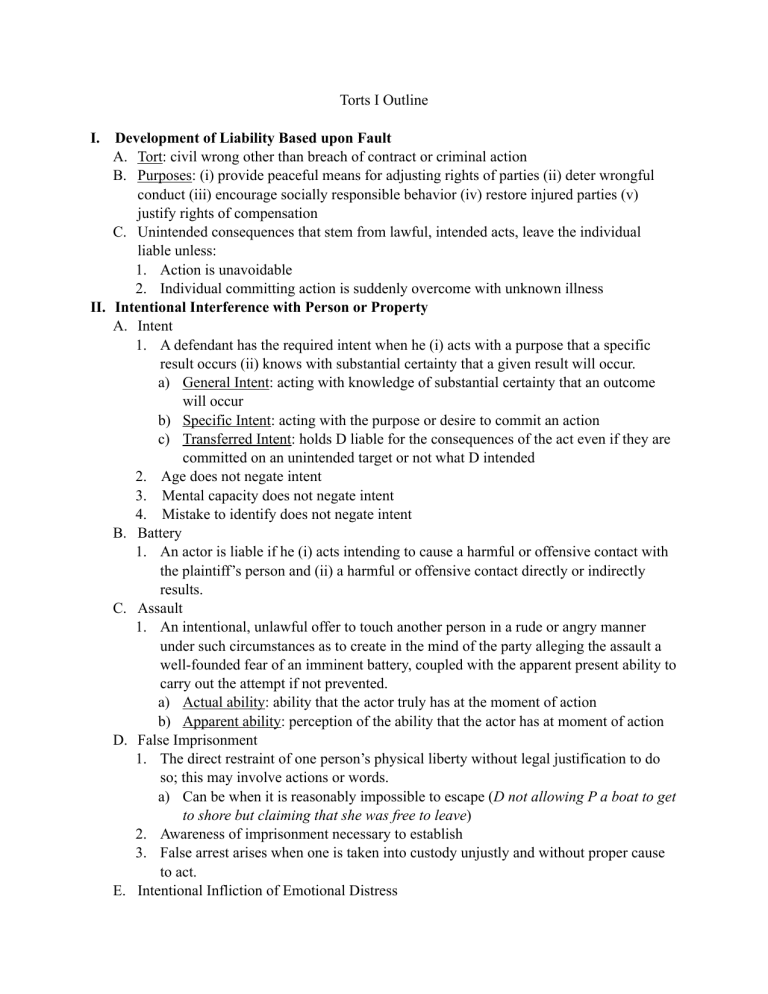
Torts I Outline I. Development of Liability Based upon Fault A. Tort: civil wrong other than breach of contract or criminal action B. Purposes: (i) provide peaceful means for adjusting rights of parties (ii) deter wrongful conduct (iii) encourage socially responsible behavior (iv) restore injured parties (v) justify rights of compensation C. Unintended consequences that stem from lawful, intended acts, leave the individual liable unless: 1. Action is unavoidable 2. Individual committing action is suddenly overcome with unknown illness II. Intentional Interference with Person or Property A. Intent 1. A defendant has the required intent when he (i) acts with a purpose that a specific result occurs (ii) knows with substantial certainty that a given result will occur. a) General Intent: acting with knowledge of substantial certainty that an outcome will occur b) Specific Intent: acting with the purpose or desire to commit an action c) Transferred Intent: holds D liable for the consequences of the act even if they are committed on an unintended target or not what D intended 2. Age does not negate intent 3. Mental capacity does not negate intent 4. Mistake to identify does not negate intent B. Battery 1. An actor is liable if he (i) acts intending to cause a harmful or offensive contact with the plaintiff’s person and (ii) a harmful or offensive contact directly or indirectly results. C. Assault 1. An intentional, unlawful offer to touch another person in a rude or angry manner under such circumstances as to create in the mind of the party alleging the assault a well-founded fear of an imminent battery, coupled with the apparent present ability to carry out the attempt if not prevented. a) Actual ability: ability that the actor truly has at the moment of action b) Apparent ability: perception of the ability that the actor has at moment of action D. False Imprisonment 1. The direct restraint of one person’s physical liberty without legal justification to do so; this may involve actions or words. a) Can be when it is reasonably impossible to escape (D not allowing P a boat to get to shore but claiming that she was free to leave) 2. Awareness of imprisonment necessary to establish 3. False arrest arises when one is taken into custody unjustly and without proper cause to act. E. Intentional Infliction of Emotional Distress 1. When an individual, without privilege to do so, intentionally causes severe emotional distress, he is liable (i) for the mental trauma caused and (ii) for any bodily harm that results. a) Act or words must be outrageous and bizarre forgoing human decency F. Trespass to Land 1. Occurs when an actor (i) enters the land in possession of another (ii) remains on the land (iii) places or projects any object on it. a) Any level of entry will infer some damage, no matter how small 2. May be committed by the continued presence on the land of a structure, chattel, or other thing when the possessor consents but the actor remains interacting with the land for longer than consented a) Continuing trespass 3. “Land” extends upward from the soil to the point above in space G. Trespass to Chattels 1. TC occurs when a chattel is devalued or harm is caused in any way to it. a) Chattels are not limited to animals, can be websites, etc. b) Must have injury or devalue H. Conversion 1. The wrongful possession or disposition of another’s property as if it were one’s own in the following ways: a) By wrongly taking it b) By wrongly detaining it c) By wrongly disposing of it III. Privileges A. Consent 1. Agreement, approval, or permission regarding some act or purpose on a subjective standard. a) Implied consent: consent that is not expressed but inferred through action b) Expressed consent: consent that is verbally expressed or expressed through writing 2. Exception falls with the preservation of life or limb 3. Must be acquired through non-false pretenses (agreeing to something not knowing a person’s identity negates consent) B. Self-Defense 1. The law requires (i) the force used must have been necessary (ii) it must have been reasonable for the situation. a) When the threat has been terminated, so does the privilege (retaliation is not defense) b) Insults and verbal threats do not justify self-defense c) Not necessary to retreat before using deadly force if such force is necessary 2. Defense of Others a) Must use reasonable force and the force must have been necessary 3. Defense of Property a) Must use reasonable force and the force must have been necessary b) Limited to unlawful intrusions on property C. Recovery of Property 1. When the pursuit is fresh, the owner has the right to use reasonable force to recover a) Limited to prompt discovery of a situation, not extended time afterwards 2. Force must be reasonable (inflicting serious injury not reasonable with stolen possession) D. Necessity 1. In the event that intrusion or destruction is necessary to preserve life, limb, or humanity, it is necessary. a) Must be for public interest, not private E. Authority of Law 1. Arrest without warrant is permitted, force must be reasonable. F. Discipline 1. Parents have the privilege of disciplining their children. 2. Military and naval officers have the same to subordinates. G. Justification 1. Restraint and detention, with proper cause, is not unlawful. IV. Negligence A. Elements of Cause of Action 1. Duty to use reasonable care 2. A failure to conform to the required standard 3. A reasonably close connection between the conduct and resulting injury 4. Actual loss or damage resulting to the interests of another B. Standard of Care 1. Individuals all have a standard of care that are objectively based on what a reasonably prudent person would do in a certain situation a) Drivers have a standard of care to protect passengers b) Store owners to protect customers 2. Emergency situations are not the same standard 3. Disabilities are treated on a reasonable standard for the level of the disability 4. Children operating in an adult situation are treated on an adult standard of care C. Rules of Law 1. Contributory negligence a) Plaintiff’s own action was enough to establish the injury resulting came from their own negligence (1) Reasonable care not taken by plaintiff b) Negligence of a third party whose act played a part in the plaintiff’s injury D. Violation of Statute 1. Negligence per se a) Violation against D when something happens to P as a result of a broken statute by D b) Injury occurring to a person that is in the protected class of a certain statute c) Must have an adequate excuse for violating a statute to negate E. Proof of Negligence 1. Circumstantial evidence a) Based on inference and not personal knowledge or observation b) Enough to prove knowledge c) Constructive notice: an individual “should have known” 2. Res Ispa Loquitur speaks to the thing itself a) An event that does not ordinarily occur without negligence on some part b) Elements (1) Warrants inference of negligence (2) Raises a presumption of negligence which requires jury to find negligence if D does not produce sufficient rebuttal evidence (3) Shifts the ultimate burden of proof to D V. Causation in Fact A. Sine qua non 1. Meaning an essential condition 2. Negligence is not actionable unless it is cause in fact for which recovery is sought. B. Proof of causation 1. When the negligence of D greatly multiples the chance of injury of P, proof must be assumed 2. There can be no speculation or assumption in proof 3. It is not enough that negligence and injury coexisted, they must directly relate 4. Must be a reasonable probability for which an instance has occurred C. Concurrent cases 1. Each actor is responsible for their part of the claim 2. Liability becomes joint and there is double fault D. Problems in determining which party caused the harm 1. When not able to be determined, the liability will be separated based on the probability that one was involved and their market share values
